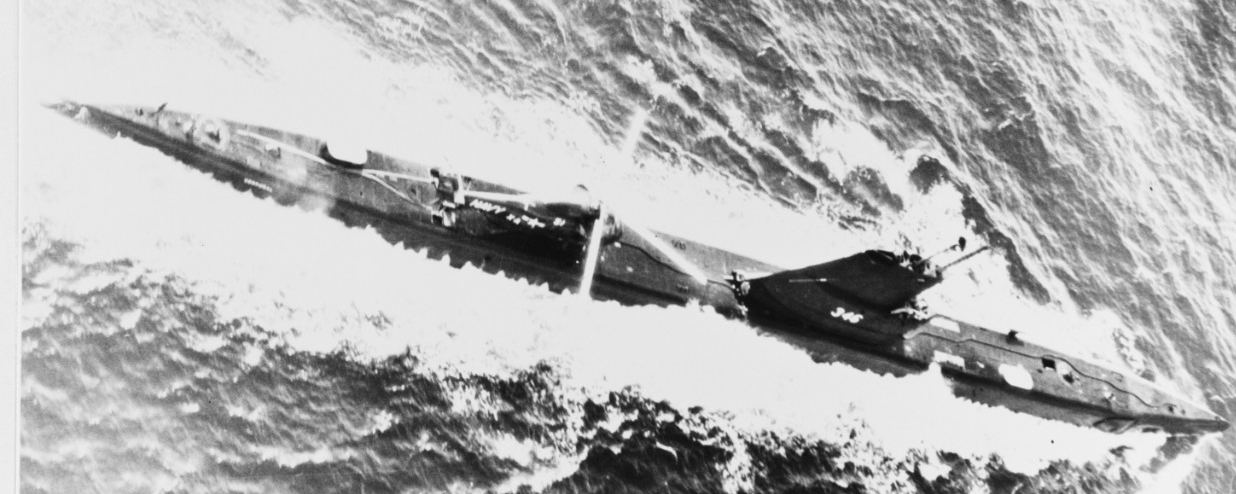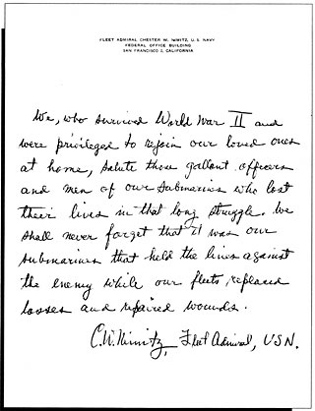

United States Submarine Losses
United States Submarine Losses
World War II
Reissued with an Appendix of
Axis Submarine Losses,
by
Naval History Division
Office of the Chief of Naval Operations
Washington: 1963 [Revised 2017]
-----
[Dedication:] To those whose contribution meant the loss of sons, brothers or husbands in this war, I pay my most humble respect and extend by deepest sympathy. As to the 374 officers and 3131 men of the Submarine Force who gave their lives in the winning of this war, I can assure you that they went down fighting and that their brothers who survived them took a grim toll of our savage enemy to avenge their deaths.
MAY GOD REST THEIR GALLANT SOULS.
From speech given in Cleveland, Navy Day 1945, by Vice Admiral C.A. Lockwood, Jr., Commander Submarine Force, U.S. Pacific Fleet January 1943-January 1946.
-----
Originally prepared by The Commander Submarine Force, U.S. Pacific Fleet, 1946; revised and reissued as NAV PERS 15,784 in 1949. Enlarged with Appendix of Axis Submarine Losses (OPNAV-P33-100, New 5-46, declassified 10-55, revised & augmented 4-63). Updated with corrections and additions in 2007 and 2017 by the staff of the Naval History and Heritage Command.
5th. Printing, 1963
Superintendent of Documents, U.S. Government Printing Office
Washington, D.C., 20402
________________________________________________________________________
________________________________________________________________________
US Navy Submarine Losses
| Albacore Amberjack Argonaut Barbel Bonefish Bullhead Capelin Cisco Corvina Darter Dorado Escolar Flier Golet Grampus Grayback Grayling |
Grenadier Growler Grunion Gudgeon Harder Herring Kete Lagarto Perch Pickerel Pompano Robalo Runner R-12 Scamp Scorpion Sculpin |
Sealion Seawolf Shark I Shark II Snook Swordfish S-26 S-27 S-28 S-36 S-39 S-44 Tang Trigger Triton Trout Tullibee Wahoo |
--i--
Preface
Long before Themistocles led Athenians to put their trust in the "wooden walls," nations had experienced the truth that the sea brings life or death. It brings blessings if held, disaster if lost.
The United States has felt the fateful impact of this fact of life many times from the American Revolution to Cuba. She has often neglected to be strong at sea and thereby gravely suffered. She did so after World War I. Consequently she met repeated disaster because she entered World War II with too small a Navy, further reduced by the Pearl Harbor treachery. The blessings of victory rose from the ashes through superb leadership, courage, skill, resolution, and a mighty fleet built to the stature required by a nation that would be mighty in the affairs of men.
Fleet Admiral Nimitz, whose Forward illumines this volume, provided much of the magnificent leadership needed. The submarine service which he had helped nurture from his younger days as a submarine skipper played a giant role indeed in transforming disaster into victory. In doing so, submariners wrote shining new epics in naval tradition.
As Lieutenant Nimitz in 1912 he had forecast, "The steady improvement of the torpedo together with the gradual improvement in the size, motive power and speed of submarine craft of the near future will result in a most dangerous offensive weapon, and one which will have a large part in deciding fleet actions."
Today giant winds of change sweep through the world. They transform empires, industry, agriculture, transport, philosophies and political systems. They transform navies. With seven league boots, strength at sea strides forward into an era of strange new powers for human destiny.
These powers rest in large part on the infinite vastness of space and the silent vastness beneath the waves. A new Navy forms before our eyes and it forms in considerable part around the submarine. Any student of history knows that there have been many "new navies"--the United States Navy has been in transition since its first ship set her course for freedom. As the industrial revolution accelerated, so did change at sea. These changes brought increasing advantages in having national strength based afloat. Atomic power, Polaris missiles, electronics, space satellites have greatly increased these advantages by shattering old limitations of time and space, of speed and endurance, of surprise and hitting strength. These phenomenal advances have concentrated dramatically in the Polaris submarine, champion of freedom.
The submarine had its first success in war a century ago on 17 February 1864 when CSS Hunley and USS Housatonic on the outskirts of Charleston harbor. Hunley's torpedo was an explosive charge at the end of a spar that had to be rammed into the hostile warship. Her engines were the arms of men on cranks. What a far cry to the godlike power of the atoms, the giant reach of Polaris into the heart of continents where no spot is safe from today's long arm of the sea.
The first practical submarine, like the aircraft, came with the developments of the advancing industrial revolution such as the internal combustion engine, powerful electric batteries, improved genii of machines of many types. The submarine played its first important role in expanding naval power during World War I. For the United States it reached flood tide in World War II.
The new traditions submariners wrote, of valor, fortitude, service to America, shine for the future with the lustre of Jones, Decatur, Farragut. In writing them, men suffered and died for America, as they did in all parts of the complex Navy, as they did in all services. Wars cannot be fought without loss; and he who wears the U. S. Navy's uniform must be ready to give his life instantly in action as well as steadily in long years of service. To record the last great sacrifice of those who served under the sea, "SUBMARINE LOSSES, WORLD WAR II" was published soon after V-J Day.
Requests for this little memorial volume have mounted during the years while the last edition has been out of print. This reissue is an attempt to broaden and at the same time to sharpen the perspective of the original work by including in rough outline the scope of the enemy submarine effort and its frustration by the Allies. The resultant inescapable comparisons can only make more meaningful the tribute this book pays to the brave Americans of the Silent Service who were "loyal jusqu' à mort" in 52 final patrols.
Extensive further research ought to be done before anyone speaks categorically on the fate of many an undersea raider. Until the deep gives up its dead, some mysteries will never be written off as anything better than "educated guesses."
--iii--
This book could hardly have been rethought and executed in its present form without the devoted efforts of the Assistant Director of Naval History, Captain F. Kent Loomis, USN (Ret.), assisted by Lieutenant John R. Ganey, USN, both splendid veterans of submarines. The editorial correction, compilation and detail of preparation for publication were handled by Mr. Jesse B. Thomas of this Division, assisted by Mr. Donald R. Martin, both working with their well known meticulous devotion to accuracy. The Japanese loss data, following correspondence with observers abroad, were extensively reworked and reconciled by an able former member of the Division's staff, Dr. K. Jack Bauer, now at Morris Harvey College, Charleston, West Virginia. An outstanding thesis, "American Antisubmarine Operations in the Atlantic, May 1943-May 1945," by Dr. Philip K. Lundeberg, another one time staffer of the Division and now Curator of Naval History at the Smithsonian Institution, has been an invaluable source. The sound historical knowledge and wise judgment of Mr. Dean C. Allard, head of the Classified Operational Archives, have repeatedly served us well, as have the special talents of Lieutenant Commander Richard S. Pattee, USN. Assessments by naval scholars Erich Gröner, Jürgen Rohwer, Hans Herlin and Kristall journal in Germany; by former Commander (Constructor) Shizuo Fukui in Japan; Captain S. W. Roskill, RN, in Great Britain; and Commander Marc Antonio Bragadin, in Italy, have been tentatively accepted as authoritative in all but a few moot cases. Certain details of Japanese submarine losses are included thanks to the timely help of Mr. Joseph D. Harrington, who loaned working papers from his popularly written paperback on human torpedoes and from his book manuscript on enemy undersea operations during the Pacific War.
The British Admiralty's data are accepted as authoritative in most cases involving U-boat losses to British warships and aircraft. For careful and timely review of the German section of this work we are indebted once again to Commander Peter Kemp, RN, and his dedicated staff, as well as to naval historian Richard Hough of London for advice and counsel in this some-times baffling field.
Thanks are also due to some 20 next of kin who responded to the call for elusive photographs of their late husbands or fathers to complete the gallery of 51 gold star skippers in this book.
* * *
Today under the vast and lonely waves, submariners stand watch for America and the noble dream of freedom for all-so close to man's grasp, so far from the purpose of tyranny. George Washington, and other Polaris submarines bearing names of famous Americans, guard liberty as their namesakes fought for it-not just for the United States, but for the world.
In reissuing this little volume, we commission it as a memorial not only to those whose exploits and gallant sacrifice appear herein. It is tribute to those who serve today, to the memory of each who gave his life in the past, to those who will serve as well in the future. It is tribute not alone to submariners, but to all brave men who serve at sea, where the complex demands of our ever changing Navy require many types of ships and many types of skills. For in their lives (as in the lives of ships they direct and give spirit and meaning by their devotion) throbs much of the destiny of freedom.
Ernest M. Eller, Rear Admiral,
United States Navy, Retired,
Director, Division of Naval History
Office of the Chief of Naval Operations
--iv--




